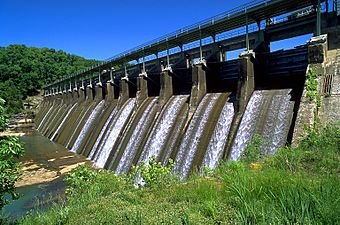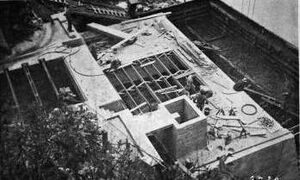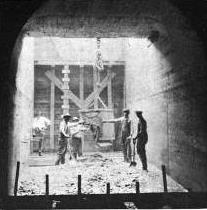Great Falls Dam (Tennessee) facts for kids
Quick facts for kids |
|
|
Great Falls Hydroelectric Station
|
|

Great Falls Dam
|
|
| Location | Warren / White counties, Tennessee, United States |
|---|---|
| Nearest city | Rock Island, Tennessee |
| Built | 1915-1916 |
| NRHP reference No. | 90001004 |
| Added to NRHP | 1990 |
The Great Falls Dam is a big hydroelectric dam in Tennessee. It sits between White County and Warren County. This dam is special because it's the only one the Tennessee Valley Authority (TVA) owns outside the main Tennessee River area.
The dam creates a large lake called Great Falls Lake, which is about 1,830 acres big. Water from the dam flows into Center Hill Lake. Building the dam in 1917 was a huge success! It was the first time anyone could control the wild Caney Fork River, which used to flood a lot. What's cool about this dam is how it works. Most of the water travels through an underground tunnel to reach the Power House, which is about 0.75 miles away from the dam itself.
The dam gets its name from the amazing waterfalls and fast-moving water (rapids) below it. The river section below the Power House is famous around the world for whitewater kayaking. The dam and the river below it are surrounded by Rock Island State Park.
Contents
Where is Great Falls Dam Located?
The Great Falls Dam is about 94 miles up the Caney Fork River from where it joins another river. It's located right after the Caney Fork meets the Collins River. These two rivers almost touch at a spot called the Narrows. This spot is like a "land bridge" connecting a piece of land to the main area.
Two tunnels carry water from the Collins River part of Great Falls Lake to the dam's powerhouse. This powerhouse is on the Caney Fork, about 0.75 miles downstream from the dam. Great Falls Lake stretches for 22 miles along the Caney Fork and about 10 miles along the lower Collins River. The lake also includes a small part of the lower Rocky River, which flows into the Caney Fork about a mile east of the dam.
How Powerful is Great Falls Dam?
The Great Falls Dam is made of concrete and is 92 feet high and 800 feet long. It can produce 33,800 kilowatts of electricity. The dam has 18 gates that can release a lot of water, up to 150,000 cubic feet per second.
Great Falls Lake can hold about 49,000 acre-feet of water to help prevent floods. It has about 120 miles of shoreline and covers 1,830 acres of water.
Building the Dam: A History of Challenges
For many years, people tried to use the powerful water of the Caney Fork River. But the river was wild and often flooded, destroying their projects. One of the first big businesses to use the river's power was the Bosson Mill. This mill made flour and processed wool from the 1860s until a flood destroyed it in 1882.
Later, the Falls City Cotton Mill Company built a cotton mill and a town called Falls City in 1892. They made some money until 1902. That year, a huge flood on Good Friday destroyed their bridge and power plant. The mill had to close, but the old mill building and a "spring castle" from the town are still there today.
Around 1900, the city of Nashville needed more electricity for its growing industries. In 1901, a businessman named Arthur Dyer bought land to build a dam. But he couldn't get enough money for the project. In 1912, he sold his company to the Tennessee Power Company.
The first plans for the dam were for it to be 110 feet high. Water was supposed to travel a long way through tunnels and canals to reach the powerhouse. This would have used a total drop of 235 feet in the water level.
The Tennessee Power Company started building the dam's base. But within a month, the Caney Fork River flooded again! It ruined their digging work and destroyed temporary dams called cofferdams. The company faced money problems again. However, they were able to restart construction in 1915. By late 1916, the 40-foot-high dam was finished. The power plant began operating on January 1, 1917.
In 1922, the Tennessee Power Company joined with other companies to form the Tennessee Electric Power Company (TEPCO). TEPCO made the Great Falls Dam even more powerful. They raised the dam by 35 feet and added a second generator at the powerhouse.
The dam faced its first big challenge in March 1929. Heavy rains caused the Caney Fork to flood to record levels. Debris and uprooted trees crashed into the dam. The Great Falls Power House was flooded, and a power station was destroyed. But the dam held strong!
TVA Takes Over and Improves the Dam
In 1933, the Tennessee Valley Authority (TVA) was created. TVA was put in charge of controlling floods in the Tennessee River area, where most of TEPCO's dams were. The head of TEPCO, Jo Conn Guild, did not like TVA. He even went to court to say that the TVA law was against the rules.
However, the U.S. Supreme Court said the law was fine. So, TEPCO had to sell its dams and other property to TVA for $78 million. This amount included $3.5 million for the Great Falls Dam.
After TVA bought the dam, they started making improvements right away. By 1946, they had fixed a lot of the water leaks through the cliffside, which had been a problem since the dam was built. TVA also built a new switchyard and a control building. In the late 1960s, TVA let the state of Tennessee use part of the Great Falls area. This led to the creation of Rock Island State Park, which opened in 1969.





